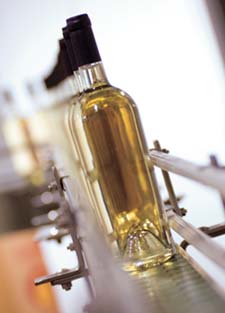 |
 |
| current issue |  |
past issues |  |
send a letter/news |  |
address update |  |
advertise |  |
about us |  |
alumni home |
Features
Grape ArdorPage 3 of 4

|
Paul had a wine auction before he had a winery. In its 11 years, the Headlands Foundation auction has raised $3 million for everything from books for pre-school children to a tractor cab for a local food bank. He loves the nonprofit work and the wine community, but during his years sidelined from the mortgage business, Paul missed the financial community. Not making money, he decided, is not fun. Besides, his friends wanted to work with him again.
So in 2003 he started Paul Financial with five employees. Today it has 200, who occupy a building that a friend kept vacant for him. (Most of his stories about business, like most of his stories about fun, begin "I have a friend who ...") Many of the employees have worked with Paul before, or they're related to past or present employees. Judy Miller, who essentially runs his social life as special projects coordinator, is married to Joe Miller, one of Paul's friends from college. The Millers moved to California mostly because Paul made the place sound so good. Gareth Staglin, a fellow winery owner and supporter of local nonprofits, says people often follow Paul's lead. When it comes to charity, Staglin says, "Peter's a Pied Piper of good causes."
On a May afternoon in the chilly warehouse, Paul proposes a tasting tour of wine-in-progress. Gulyash and Grove Street sales director Brent Ferro assemble the necessities: glasses, a bucket for spitting or dumping, a spray bottle of rubbing alcohol, and "the thief," a tool resembling an angled glass turkey baster that sucks wine from barrels and squirts it into glasses. Gulyash presents each pale or ruby liquid for tasting, and a reverent silence reigns before the adjectives begin: creamy, chewy, long finish (and in one case funky, vile, sweaty socks—but that's a local vintner's wine that they're trying to fix). One moment the men sound like engineers discussing the space shuttle, trading terms like oxygen pickup and capsule-to-bottleneck interference. The next, they're fathers assessing their offspring: "For a baby, that's tremendous."

|
Amid towering racks of oak barrels, they linger to contemplate the mysterious relationship of wine and wood. Wine lovers can talk forever about the flavors—spicy, buttery, vanilla—imparted by barrels of European vs. American oak. Gulyash says the cooper's construction methods affect the wine even more than the type of wood does. Variables include how the wood is aged, how it's split, and especially how it's "toasted." Toasting is using fire to char the inside of a barrel. The degree of "cooking" leads to the barrel's classification as light toast, medium toast or heavy toast; the stenciled letters LT, MT or HT on the ends of the barrels form one more coded message to those in the know.
What happens inside the barrels is chemistry, but it's also magic. A small winery's machinery is not magic, and there's surprisingly little of it. At Grove Street, grapes coming off the trucks are weighed and loaded into the crusher, which removes the stems. The rest of the crushed grape, called the must, moves to the press, which gently separates the juice from the seeds and skins. Skins are what give wine color, so white wine gets minimal skin contact. For red wine, the whole crushed grape goes into the fermentation tank; how long the wine sits with the skins determines how dark its color will be.
Page: < Prev 1 2 3 4 Next >Easy to print version

